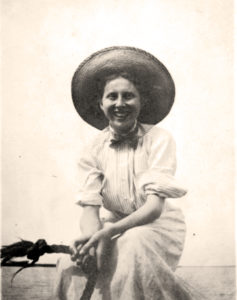Caroline Dormon
Caroline Dormon made monumental contributions to the conservation of Louisiana's natural and cultural resources. A passion for native plants and old-growth forests, coupled with a strong feeling of kinship with Native Americans, shaped Dormon's life and work.

Courtesy of Northwestern State University.
Black and white reproduction of a photograph of Caroline Dormon as a young woman.
Though diminutive in size, writer and environmentalist Caroline Dormon made monumental contributions to the conservation of Louisiana’s natural and cultural resources. A passion for native plants and old-growth forests, coupled with a strong feeling of kinship with Native Americans, shaped Dormon’s life and work. In the 1920s and 1930s, she was instrumental in persuading the US Forest Service to establish a national forest, now known as Kisatchie National Forest. She also worked with Louisiana Highway Department to beautify the state’s highways and published six books about Louisiana’s native plants.
Early Life
Caroline Coroneos Dormon was born July 19, 1888, at her family’s summer retreat of Briarwood in rural Natchitoches Parish. Her parents, James and Caroline Trotti Dormon, encouraged Caroline and her siblings to explore the longleaf pine forests of Kisatchie Wold, where they developed a deep, abiding connection to the natural world. She recalled, “We were rather delicate children, of a nervous temperament; so…our parents made it possible for us to spend every moment we were outside the schoolroom in the woods…. And we didn’t play Indians, we were Indians.” The Dormon children were encouraged to read scholarly and government publications exploring the history and diverse cultures of ancient Americans, as well as the myriad problems faced by a contemporary Native American population in transition. Her lifelong interest in Native Americans was thus heavily shaped by her belief that contemporary tribes, like old-growth forests, were quickly disappearing.
After graduating in 1907 from Judson College in Marion, Alabama, with a degree in art, Dormon served briefly as a public school teacher before succumbing to the primal attraction of the pine forest of her birth. Chronic ill health and an unconventional upbringing made it difficult for Dormon to hold a standard wage-paying job. Only thirty years old, Dormon “retired to private life,” in 1918, moving with her older sister Virginia Miller to Briarwood, where she planned to “put into usable form the store of information which I had been gathering all my life.” Dorman never married, devoting her life to the preservation of the natural world and traditional cultures around her.
Career in Environmentalism and Cultural Conservation
Lured out of her self-imposed retirement in 1920, Dormon joined the Louisiana Department of Conservation to coordinate a program of educational outreach and public relations that she designed. That same year, she also joined the Society of American Foresters as the first female associate member. From this platform, Dormon engaged in years of aggressive lobbying, finally persuading state leaders and the US Forest Service to establish Kisatchie National Forest, which today comprises more than 600,000 acres in public lands. Although she considered herself “in no sense a clubwoman,” Dormon became active in the Louisiana Federation of Women’s Clubs, where she served as state chairman of conservation. Through avid letter-writing, she extended and strengthened networks among those who could advance her efforts to gain public support for natural resource conservation.
With the strain of poor health and with little patience for state government, Dormon retired to Briarwood once again and resumed her perennial role as nature’s student in 1923. She eked out a living by landscape contracting, botanical paintings, speaking engagements, and publications. Widely known for her work with forestry and native plants, Dormon was also a passionate advocate for Louisiana’s cultural resources, spearheading efforts to identify and protect archaeological sites throughout the state. Seeking out tribal artists and traditionalists, Dormon recorded stories in native languages and promoted the work of Choctaw, Koasati, and Chitimacha basket weavers, bringing crucial support to struggling families and fostering a new appreciation for these ancient, enduring traditions. She campaigned on the national and state levels for recognition and assistance for Native Americans, and promoted traditional arts as an economic base in tribal communities. At the urging of John R. Swanton of the Smithsonian’s Bureau of American Ethnology (BAE), Dormon became the only female member of the De Soto Commission—a group formed to determine the route Spanish explorer Hernando De Soto took across the American Southeast in the 1540s. She also advised Swanton where to undertake federal archaeological projects, and helped connect linguists and ethnologists with Louisiana Indians.
Throughout her lifetime, Dormon rarely strayed far from her heart’s anchor, Briarwood. With the support of her sister, and friends like Cammie Henry of Melrose Plantation, Edith Stern of Longue Vue, Lyle Saxon of the Federal Writers’ Project, John R. Swanton of the BAE, John Collier of the Bureau of Indian Affairs, and others, Dormon was able to satisfy her voracious thirst for knowledge on a wide range of interests. In the process, she was able to educate and enlighten the public about the beauty and wonder to be found in old-growth forests, hidden bogs, and Native American basketry. Once a lone voice in the wilderness, Caroline Dormon is now considered the state’s first true conservationist, whose efforts helped to protect Louisiana’s vast natural and cultural treasures. She died November 21, 1971. The Dormon Collection is located at the Eugene P. Watson Memorial Library of Northwestern State University in Natchitoches.
